BUICK RIVIERA 1993 Manual PDF
Manufacturer: BUICK, Model Year: 1993, Model line: RIVIERA, Model: BUICK RIVIERA 1993Pages: 324, PDF Size: 16.01 MB
Page 71 of 324
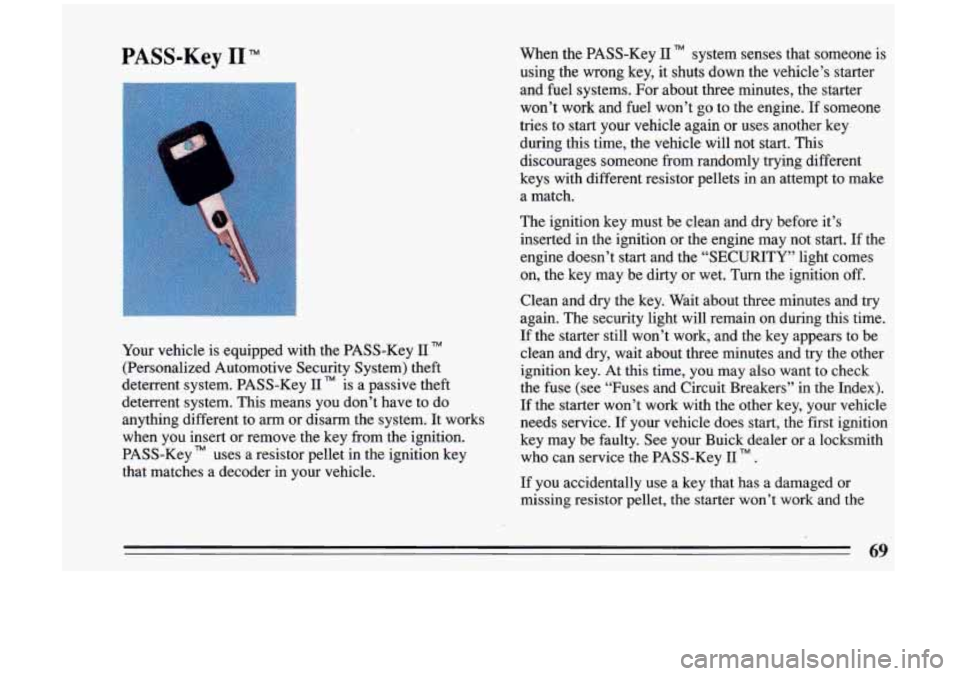
PASS-Key I1 TM
Your vehicle is equipped with the PASS-Key I1
(Personalized Automotive Security System) theft
deterrent system. PASS-Key
11 TM is a passive theft
deterrent system. This means you don’t have to do
anything different to arm or disarm the system. It works when you insert or remove the key from the ignition.
PASS-Key
TM uses a resistor pellet in the ignition key
that matches a decoder in your vehicle. When
the PASS-Key
I1 TM system senses that someone is
using the wrong key, it shuts down the vehicle’s starter
and fuel systems. For about three minutes, the starter
won’t work and fuel won’t
go to the engine. If someone
tries to start your vehicle again or uses another key during this time, the vehicle will not start. This
discourages someone Erom randomly trying different
keys with different resistor pellets in an attempt to make
a match.
The ignition key must be clean and dry before it’s
inserted in the ignition or the engine may not start. If the
engine doesn’t start and the “SECURITY” light comes
on, the key may be dirty or wet. Turn the ignition
off.
Clean and dry the key. Wait about three minutes and try
again. The security light will remain on during this time. If the starter still won’t work, and the key appears to be
clean and dry, wait about three minutes and try the other
ignition key. At this time, you may also want
to check
the fuse (see “Fuses and Circuit Breakers” in the Index).
If the starter won’t work with the other key, your vehicle
needs service. If your vehicle does start, the first ignition
key may be faulty. See your Buick dealer or
a locksmith
who can service the PASS-Key I1
.
If you accidentally use a key that has a damaged or
missing resistor pellet, the starter won’t work and the
69
Page 72 of 324
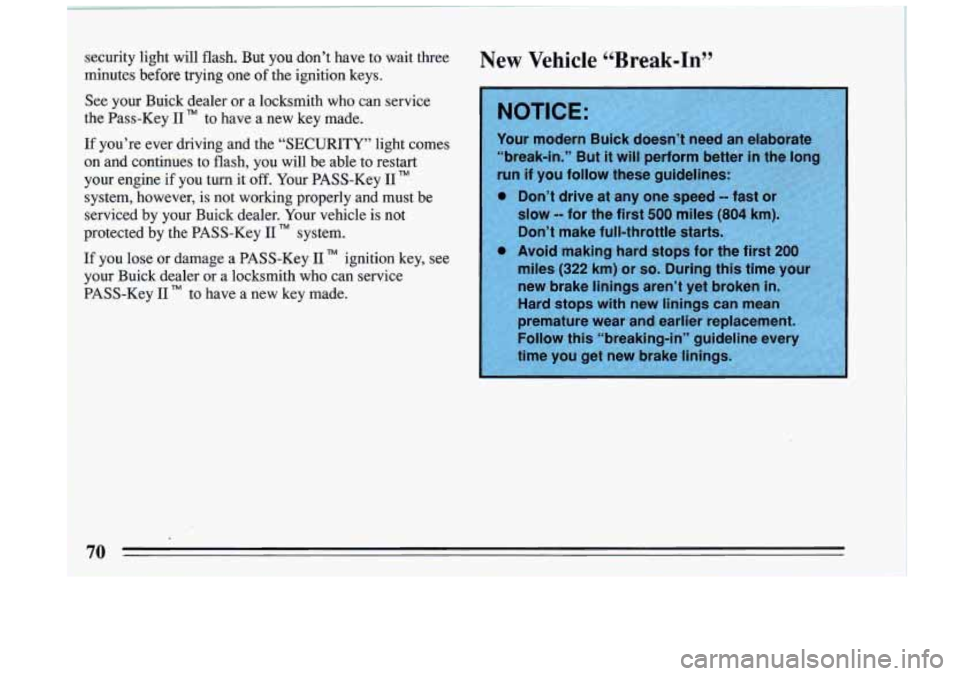
Se6urity light will flash. But you don’t have to wait three
minutes before trying one
of the ignition keys.
See
your Buick dealer or a locksmith who can service
the Pass-Key
11 TM to have a new key made.
If you’re ever driving and the “SECURITY” light comes on and continues to flash,
you will be able to restart
your engine if
you turn it off. Your PASS-Key 11 TM
system, however, is not working properly and must be
serviced by your Buick dealer. Your vehicle is not
protected
by the PASS-Key 11 system.
If you lose
or damage a PASS-Key 11 ignition key, see
your Buick dealer or a locksmith who can service
PASS-Key I1
TM to have a new key made.
70
Page 73 of 324
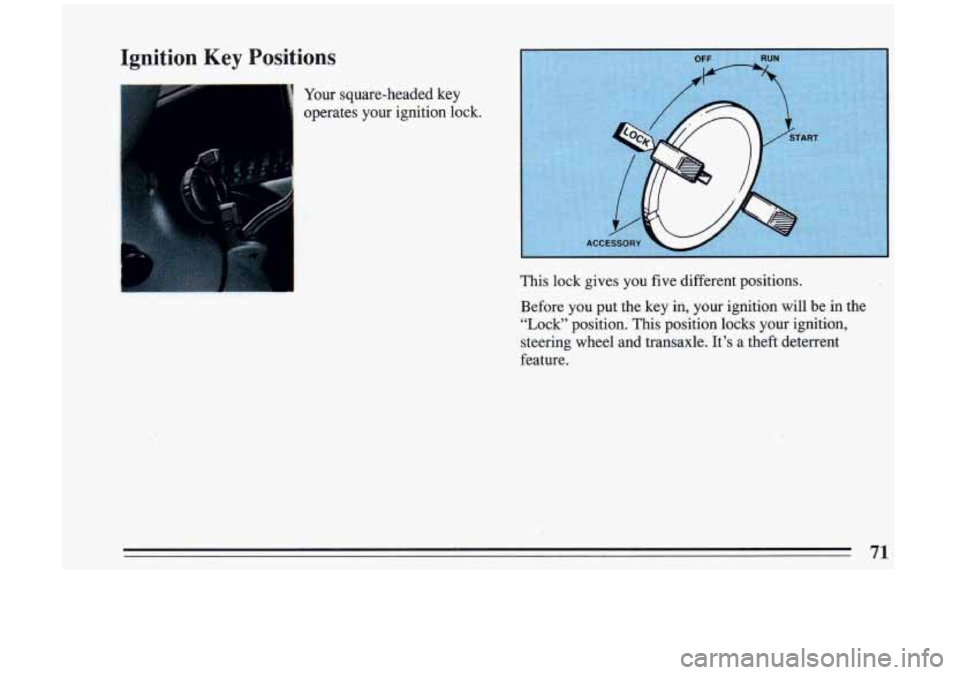
Ignition Key Positions
Your square-headed key
operates your ignition lock.
71
Page 74 of 324
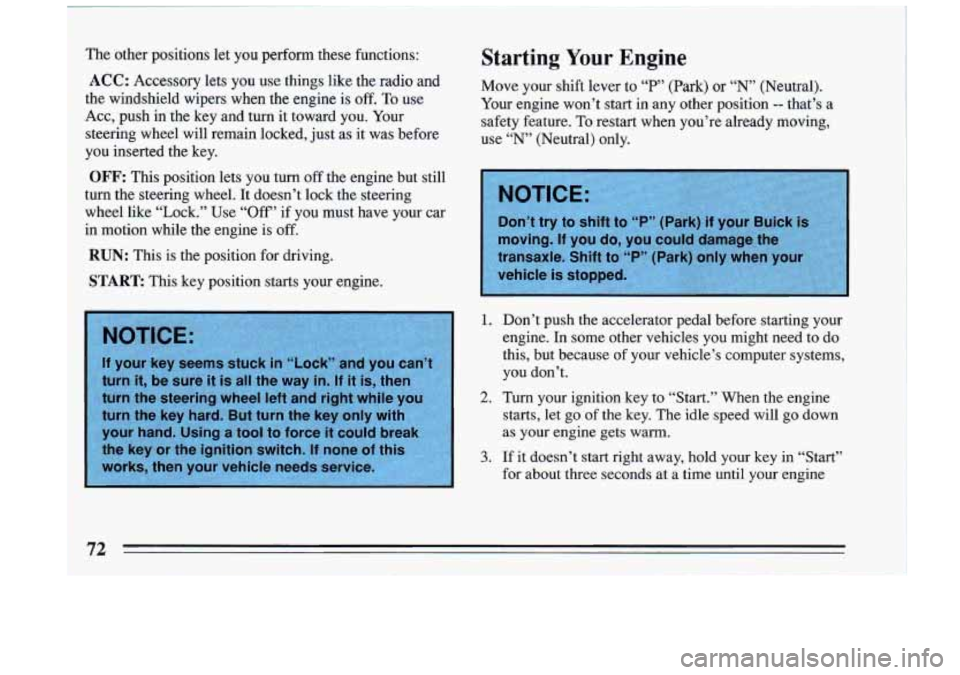
Starting Your Engine The other positions let you perform these functions:
ACC: Accessory lets you use things like the radio and
the windshield wipers when the engine is
off. To use
Acc, push
in the key and turn it toward you. Your
steering wheel will remain locked, just as it was before
you inserted the key.
OFF: This position lets you turn off the engine but still
turri the steering wheel. It doesn’t lock the steering wheel like “Lock.” Use “Off’ if you must have your car
in motion while the engine is off.
RUN: This is the position for driving.
START This key position starts your engine. Move your shift lever
to “P,’ (Park) or “N’ (Neutral).
Your engine won’t start in any other position
-- that’s a
safety feature, To restart when you’re already moving,
use
“N” (Neutral) only.
1. Don’t push the accelerator pedal before starting your
engine.
In some other vehicles you might need to do
this, but because of your vehicle’s computer systems,
you don’t.
starts, let go of the key. The idle speed will go down
as your engine gets warm.
3. If it doesn’t start right away, hold your key in “Start”
for about three seconds at a time until your engine
2. Turn your ignition key to “Start.” When the engine
72
Page 75 of 324
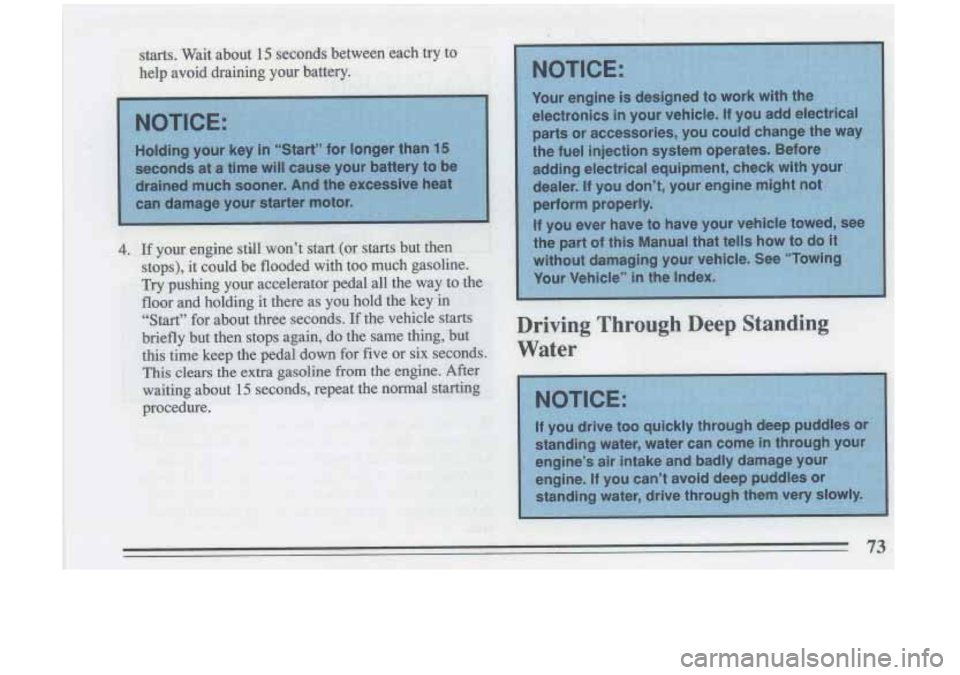
Page 76 of 324
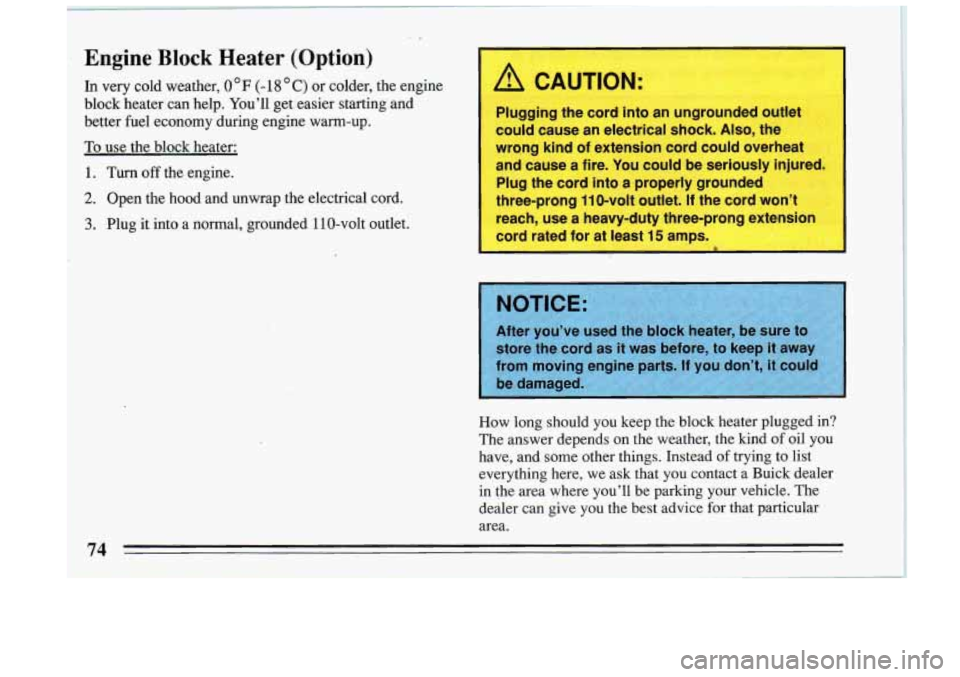
Engine Block Heater (Option)
In very cold weather, 0 F (- 18 C) or colder, the engine
block heater can help. You’ll get easier starting and
better fuel economy during engine warm-up.
j To use the block heater: I
I. Turn off the engine.
L. Open the hood and unwrap the electrical cord.
1 3. Plug it into a normal, grounded 110-volt outlet.
A CAUTION:
Plugging the cord into an ungrounded outlet
could cause an electrical shock.
Also, the
wrong kind of extension cord could overheat
and cause
a fire. You could be seriously injured.
Plug the cord into
a properly grounded
three-prong 110-volt outlet.
If the cord won’t
reach, use
a heavy-duty three-prong extension
cord rated for at least
15 amps.
How long should you keep the block heater-plugged in?
The answer depends on the weather, the kind
of oil you
have, and some other things. Instead
of trying to list
everything here, we ask that you contact
a Buick dealer
in the area where you’ll be parking your vehicle. The
dealer
can give you the best advice for that particular
area.
74
Page 77 of 324

Automatic- Transaxle
There are SL . dral different positions for your shift lever.
0 P (Park)
This locks your front wheels. It’s the best position to
use when you start your engine because your vehicle
can’t move easily.
A CAU ION:
It is dangerous to get out of your vehicle if the
shift lever
is not fully in “P” (Park) with the
parking brake firmly set. Your vehicle can roll.
Don’t leave your vehicle when the engine
is
running unless you have to. If you have left the
engine running, the vehicle can move suddenly.
You or others could be injured.
To be sure your
vehicle won’t move, when you’re on fairly level
ground, always set your parking brake and move the shift lever to “P” (Park).
See “Shifting Into “P” (Park)”
in the Index. If
you are parking on a hill, also see “Parking on
Hills” in the Index.
L
Ensure the shift lever is fully in “P’ (Park) range before
starting the engine. Your Buick has a brake-transaxle
shift interlock. You have to fully apply your regular
brake.s before you can shift from
“P’ (Park) when the
ignition key is in the “Run” position. If you cannot shift
out of
“P’ (Park), ease pressure on the shift lever - push
the shift lever all the way into “P” (Park) and also
release the shift lever button on floor shift console models as you maintain brake application. Then move
75
Page 78 of 324
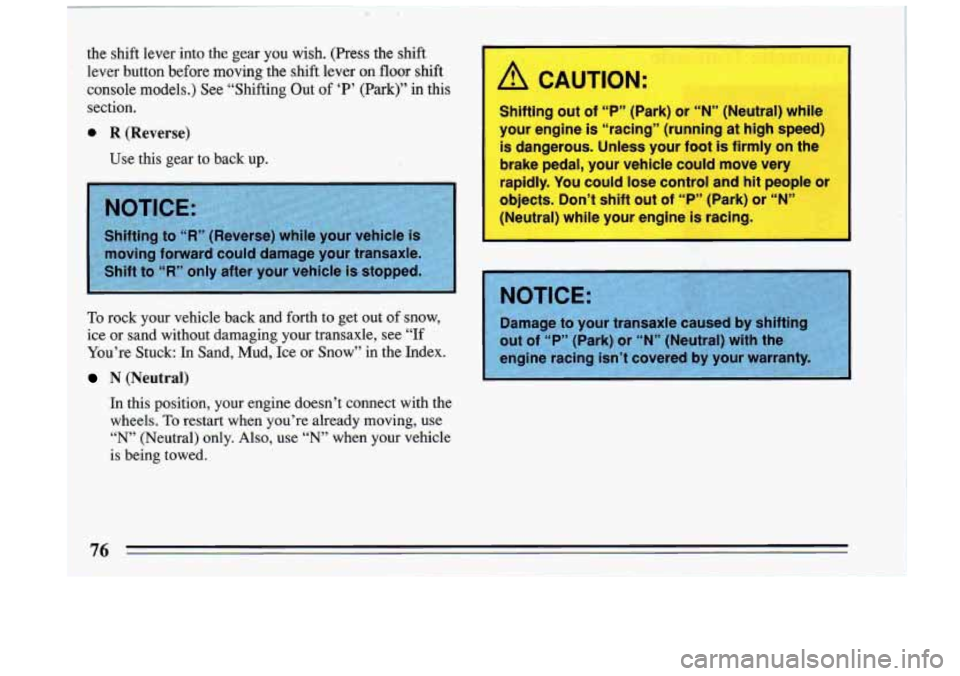
the shift lever into the gear you wish. (Press the shift
lever button before moving the shift lever
on floor shift
console models.) See “Shifting Out
of ‘P’ (Park)’? in this
section.
0 R (Reverse)
Use this gear to back up.
76
I
A CAUTION:
To rock your vehicle back and forth to get out of snow,
ice or sand without damaging your transaxle, see
“If
You’re Stuck: In Sand, Mud, Ice or Snow” in the Index.
N (Neutral)
In this position, your engine doesn’t connect with the wheels.
To restart when you’re already moving, use
“N” (Neutral) only. Also, use “N’ when your vehicle
is being towed.
Shifl J out of “P” (Park) or “N” (Neutral) while
your engine
is “racing” (running at high speed)
is dangerous. Unless your foot is firmly on the
brake pedal, your vehicle could move very
rapidly. You could lose control and
hit people or
objects. Don’t shift out
of “P” (Park) or “N”
(Neutral) while your engine is racing.
I
Page 79 of 324
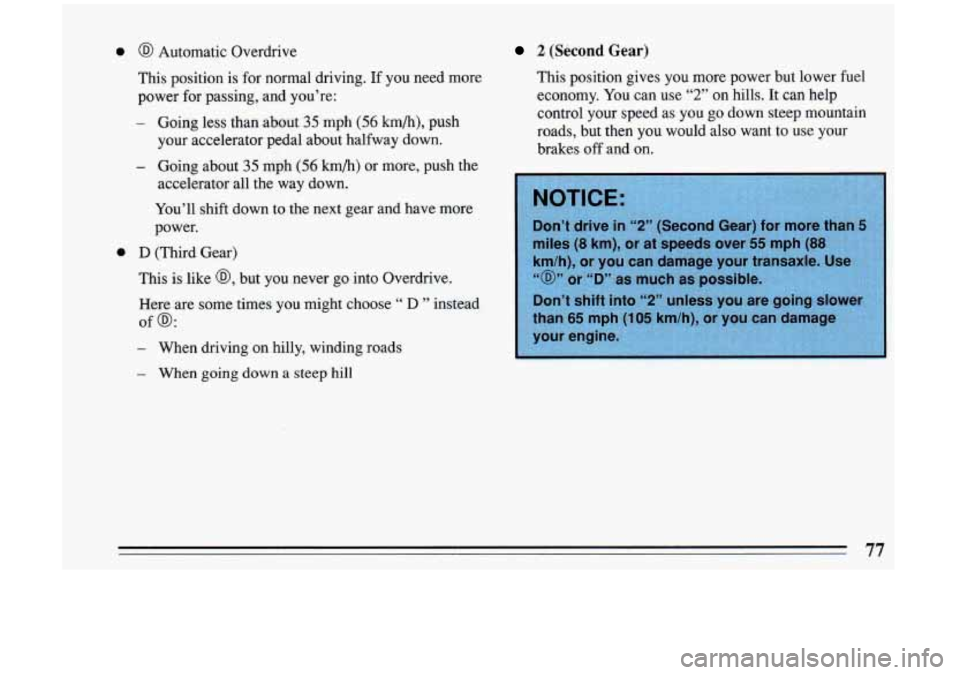
0 @ Automatic Overdrive
This position is for normal driving.
If you need more
power
for passing, and you’re:
- Going less than about 35 mph (56 km/h), push
your accelerator pedal about halfway down.
- Going about 35 mph (56 km/h) or more, push the
accelerator all the way down.
0
You’ll shift down to the next gear and have more
power.
D (Third Gear)
This is like
@, but you never go into Overdrive.
Here are some times you might choose
“ D ” instead
of
@:
- When driving on hilly, winding roads
- When going down a steep hill
2 (Second Gear)
This position gives you more power but lower fuel
economy. You can
use “2” on hills. It can help
control your speed as you
go down steep mountain
roads, but then you would also want to use your brakes
off and on.
77
Page 80 of 324
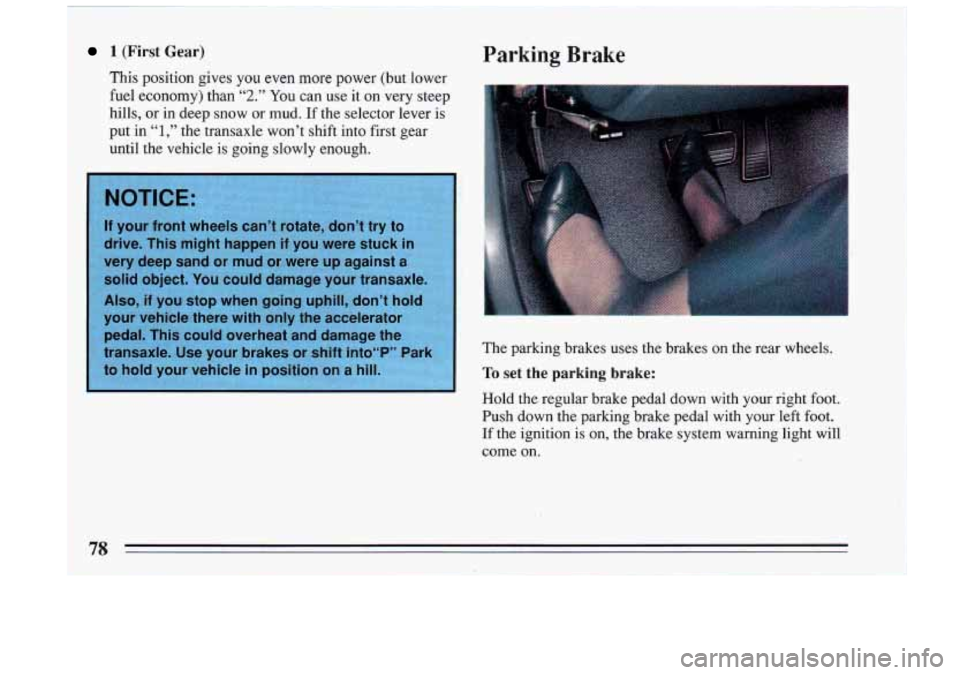
1 (First Gear) Parking Brake
This position gives you even more power (but lower
fuel economy) than
“2.” You can use it on very steep
hills, or in deep snow or mud. If the selector lever is
put in
“1,” the transaxle won’t shift into first gear
until the vehicle is going slowly enough.
The parking brakes uses the brakes on the rear wheels.
To set the parking brake:
Hold the regular brake pedal down with your right foot.
Push down the parking brake pedal with your left foot.
If the ignition is on, the brake system warning light will
come on.